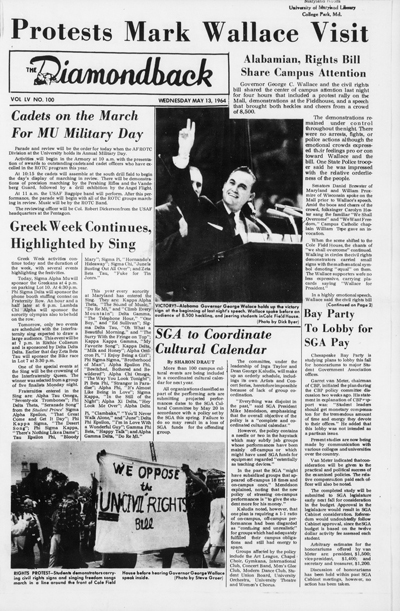Golden Age of Student Activism
Good Trouble
In 1966, Student Nonviolent Coordinating Committee member Stokely Carmichael introduced the term Black Power. This became part of the catalyst that led to national demands for Black Studies departments, diverse faculty and staff, and an increase in Black student admissions in places of higher education. A few years later, The Black Explosion was established as a publication designed to fill the gap in student newspapers' coverage of Black news, events, experiences, and perspectives. Founding editor Patricia Wheeler (class of ‘73), said, "If you don't tell your own story, no one else will." The publication covered topics like Earth, Wind and Fire, visits from scholars and political figures like Marion Berry, Walter Faunteroy, the birth of Black Studies at the University of Maryland (UMD), inequities on campus, the judicial system, and local and international current affairs.
The 1960s and 70s saw the passing of the Voting Rights Act under President Lyndon B. Johnson and the assassination of Malcolm X and Martin Luther King Jr. The country also witnessed the development of Title IX , which prohibited discrimination in educational programs on the basis of sex, as well as a series of uprisings in support of the LGBTQ+ community. Critical moments like these ignited transformational change and served as the backdrop for the student activism that sparked protests, the takeover of administration buildings, and demands for cultural spaces at colleges and universities throughout the country.

Flier, circa 1970. Gay Student Alliance records.

"Protests Mark Wallace Visit", May 15, 1964. The Diamondback.
Despite making some strides with the desegregation of campus, the University of Maryland hosted Alabama Governor George Wallace in 1964, attracting a crowd of 8,500 attendees and ended with an evening protest in front of the library. Two years later, the campus established a chapter of the Congress of Racial Equality (CORE), which served as the precursor for the Black Student Union. This group advocated for the admission for more Black student applicants, improved equity for Black faculty and students, increased attention to police brutality, and the creation of cultural spaces on campus.

The Black Explosion staff. Terrapin, 1973. University Publications collections, Student Publications, Terrapin.
UMD, like other colleges and universities, was a part of the large swath of antiwar sentiment, with groups such as Students for a Democratic Society (SDS) protesting against the Vietnam War. In later years, there was continued interest in the intersection between international affairs and its impact on student lives. Student-led protests against the apartheid in South Africa illuminated ties to U.S. capitalism and the investments made by several profitable companies which were bedfellows with academic institutions.
Timeline
-
1959
Fitzroy Newsum, a Tuskegee airmen from Brooklyn, N.Y, graduates with a B.S., Military Science, class of 1959. Newsum may be the first undergraduate African American male to graduate at the College Park campus.
-
1966
Congress of Racial Equality (CORE) is established at UMD. This group was the precursor to the Black Student Union.
-
1967
SDS protests with 400-500 attendees during a convocation held on the University’s McKeldin Mall. Protestors demand fair housing for Black and international students, sing protest songs, discuss alcohol regulation and the draft, interrupting President Elkins' speech.
-
1968
The Black Student Union is established and represents 200 members. Goals of the BSU include Black solidarity, equity, advocating for representation in the Student Government Association and amongst faculty and staff, and increasing admission of Black students.
-
1970
The Black Explosion is established.
May 1, 1970
In response to the U.S. invasion of Cambodia, thousands of students across the country protested. A rally on McKeldin Mall led to protests along Route 1 involving 1,000 -2,000 students and 250 police officers.
-
1972
More than 400 Black Students march to the Administration Building, demanding UMD address racist incidents against Black students, establish a financial aid program , and rename the Afro-American Studies Program.
-
1973
The American Indian Cultural Society becomes an SGA-approved club.
-
1975
After months of probing, students find extensive discrimination in the athletic department, violating recently passed Title IX regulations. Complaints gathered in interviews with athletes, coaches, and students indicate alleged discrimination centered around inequitable and inadequate equipment and facilities for women.
-
1979
Fifty of UMD’s women athletes and coaches join a march on Capitol Hill supporting equitable spending for women’s and men’s sports, in honor of Title IX.

